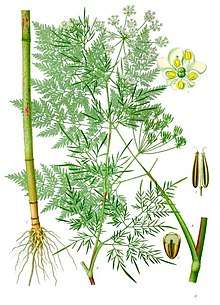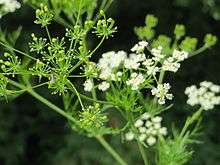Chaerophyllum bulbosum
Chaerophyllum bulbosum is a species of flowering plant from the carrot family and known by several common names, including turnip-rooted chervil, tuberous-rooted chervil, bulbous chervil, and parsnip chervil.[2] It is native to Europe and Western Asia. It was a popular vegetable in the 19th century.
| Chaerophyllum bulbosum | |
|---|---|
 | |
| Scientific classification | |
| Kingdom: | Plantae |
| Clade: | Tracheophytes |
| Clade: | Angiosperms |
| Clade: | Eudicots |
| Clade: | Asterids |
| Order: | Apiales |
| Family: | Apiaceae |
| Genus: | Chaerophyllum |
| Species: | C. bulbosum |
| Binomial name | |
| Chaerophyllum bulbosum | |
| Synonyms[1] | |
| |
This is a tall annual herb with fringelike divided leaves and large umbels of white flowers. The plant is cultivated on a small scale in parts of Europe for the edible tubers, which look like a dark gray carrot with yellowish-white flesh. After the harvest they are stored for a few months under cold conditions. During storage, sugar content increases through hydrolysis of starch by amylases.[3]
Description
Vegetative features
Chaerophyllum bulbosum is a biennial plant. In the first year, its rosette of leaves produces large amounts of starch, which are stored in the taproot to provide energy for the plant to flower in the second year. In the second year, it grows up to a height of 70 cm to > 2 m.[4]
The stem is smooth with nodes at intervals. It is hairy around the base just above the ground and may show scattered red spots. Additionally, the lower stem is often blue-rimed.
Subsequent leaves are alternate (with a single leaf attached to a node), spirally arranged, and pinnately compound, with leaf bases sheathing the stem. As the plant grows, the bases of the seed leaves, near the taproot, are pushed apart. The stem, located just above the ground, is compressed and the internodes are not distinct. When the seed stalk elongates for flowering, the tip of the stem narrows and becomes pointed, and the stem extends upward to become a highly branched inflorescence.
Flower features


Characteristic of an Apiaceae plant, Chaerophyllum bulbosum individuals produce 10 - 200 umbels. A total of 1,000 - 36,000 flowers are produced per plant. The flowers are protandrous. The styles only elongate after pollen is shed, which prevents selfing almost completely under wild, optimal pollination conditions. Chaerophyllum bulbosum is an andromonoecious plant, which means that the hermaphrodite and male flowers occur on the same plant. The sex ratio between functionally male and hermaphrodite flowers is about 80% to 20%.[4]

Wild populations
Native, wild populations are distributed in Europe from Ukraine to France and from Sweden to Italy. In France and Germany, wild populations can be found in the Rhine and the Weser River basins. It can also be found in Western and central Asia as in Turkey and Caucasus. In the wild, tuberous-rooted chervil grows in dense populations, mainly along river banks. Seeds are dispersed by hydrochory.[5]
Breeding
The plant has been grown since the Middle Ages but only survived as a garden crop in France without any named varieties. However, the first named cultivar in modern times seems to have been developed in France, named “Altan” (1986), followed by new cultivars “Véga” and “M4.10.” The new varieties are mainly characterized by low seed embryo dormancy,.[6][7] In Europe, seeds can be bought from Sativa where it is produced in collaboration with ProSpecieRara, a Swiss seed saver organization.
Usage
Chaerophyllum bulbosum is reported to be a traditional medicinal plant used by locals in Eastern Turkey. For medical properties, the rhizomes were consumed raw to increase appetite, to treat diabetes and high cholesterol levels.
It is otherwise used in cuisine for flavoring or cooked like other root vegetables. Much of the flavor comes from the skin of the tuber.[8][9] The aroma intensifies the longer the plant is stored. Eaten raw, the taste is somewhat sharp like radish, but the cooked tuber gives a subtle taste of potatoes and chestnuts with a slightly pungent taste of celery and parsnip.[10] C. bulbosum roots are high in fiber and have the same starchy quality as potatoes. They contain favorable amounts of Vitamin B and C and mineral salts.[8]
Origin and history
Tuberous-rooted chervil (Chaerophyllum bulbosum) is native to middle- and south-eastern-Europe.[6] During the 1580s, tubers of tuberous-rooted chervil were found at the local market in Wien. In 1846, the tubers arrived in France.[11] 16 years later, the tubers became even more prominent due to Phytophthora infestans, late blight of potatoes, and had been increasingly cultivated as a substitute for potatoes. At the end of the 20th century breeding programs focused on this alternative crop mainly due to its delicate flavor. Through breeding achievements of French scientists, this alternative crop gained agricultural importance in regions like Loire Valley (France) and the north of Brittany.[6][12]
Cultivation
The cultivation is similar to carrots and parsnips. An adequate site for cultivation is characterized by light and fertile soils.[13] The soil should be moderately moist. Cultivation period is from 9 up to 10 months.[14] The seeds require exposure to cold temperatures (vernalization) to break dormancy in spring. The crop cultivation starts therefore in the autumn. The dormancy ends with at least 8 weeks of continuous humidity and temperatures below 5 °C. After stratification, germination is at optimum with a temperature range between 5 and 10 °C. At temperatures above 25 to 30 °C significant germination inhibition occurs.[15] Sowing is done directly, without any seedling cultivation, from September to November. Distance between rows is usually from 20 up to 25 cm with a distance of 4 to 6 cm between seeds.[16] In the first year of growth, after sprouting in spring, the tuber develops with a leaf rosette just above ground. Voles are a common pest for this crop in the field.[17]
Harvest
Root maturity is reached when leaves turn yellow in June. The main harvest time starts in July and lasts until September. Due to the requirement of a dormancy period, it is almost mandatory to sow the seeds directly after harvest for the upcoming season. Because of this, and due to the low yield and poor germination of the seeds, Chaerophyllum bulbosum has hardly spread in commercial cultivation.[16]
Propagation
Sexual propagation through saving seeds, after harvest of the roots, is the main method of propagation. The seeds are short-lived, which means that the seeds lose their vitality easily (especially in dry seed packets); therefore, fresh seeds should be used every year. Keeping the seeds in cool and slightly damp sand might help sustain their vitality.[9]
Pollinators for Chaerophyllum bulbosum includes flies and beetles.[17]
Diseases
Similar diseases as for carrots and parsnip and other Apiaceae can occur for tuberous-rooted chervil. These are mainly the carrot fly, storage decay and root aphids. Furthermore, it can be host for other aphids, erysiphe heracley or celery mosaic virus.[18]
Gallery
References
- The Plant List: A Working List of All Plant Species, retrieved 22 December 2015
- "Taxonomy - GRIN-Global Web v 1.9.9.2". npgsweb.ars-grin.gov. Retrieved 2017-12-02.
- Geoffriau, E.; Suel, A.; Briard, M.; Péron, J.Y.; Garay, O.J. Ayala (2005). "Evolution of Amylase Activity in Tuberous-Rooted Chervil (Chaerophyllum Bulbosum L.) Roots During Storage at Various Temperatures". Acta Horticulturae (682): 1153–1158. doi:10.17660/actahortic.2005.682.152.
- REUTHER, Kerstin et CLAßEN-BOCKHOFF, Regine. Andromonoecy and developmental plasticity in Chaerophyllum bulbosum (Apiaceae–Apioideae). Annals of botany, 2013, vol. 112, no 8, p. 1495-1503.
- Le Clerc, Valérie; Suel, Anita; Geoffriau, Emmanuel; Huet, Sébastien; Briard, Mathilde (2014). "Évolution temporelle de la diversité génétique de Chaerophyllum bulbosum : conséquences sur la gestion des ressources génétiques". Comptes Rendus Biologies. 337 (5): 352–359. doi:10.1016/j.crvi.2014.03.008. PMID 24841963.
- PÉRON, J. Y. et BRIARD, M. Breeding advances in tuberous-rooted chervil (Chaerophyllum bulbosum L.), a new" old vegetable" among the Apiaceae. In : International Symposium on Sustainable Use of Plant Biodiversity to Promote New Opportunities for Horticultural Production 598. 2001. p. 235-242.
- PÉRON, J. Y., et al. Tuberous-rooted chervil: a new root vegetable for temperate climates. In : Advances in new crops. Proceedings of the first national symposium'New crops: research, development, economics', Indianapolis, Indiana, USA, 23–26 October 1988. Timber Press, 1990. p. 422-423.
- "Chervil Root". www.specialtyproduce.com. Retrieved 2017-12-02.
- "Chervil Root". growingtaste.com. Retrieved 2017-12-02.
- "Root Chervil (Chaerophyllum bulbosum)". Magic Garden Seeds. Retrieved 2017-12-02.
- Pitrat, Michel; Foury, Claude (2003). Histoires de légumes : des origines à l'orée du XXIe siècle (in French). Paris: Institut national de la recherche agronomique. ISBN 978-2738010667. OCLC 300968980.
- Péron, J.Y.; Dubost, D. (1992). "Revalorization of Lost Vegetables : A Contribution to Preservation of Genetic Resources". Acta Horticulturae (318): 263–270. doi:10.17660/actahortic.1992.318.37.
- Bussard, Léon (1909). Culture Potagère et Culture Maraîchère. Paris: Librairie J.B. Baillière et Fils. pp. 139–141.
- Vercier, Joseph (1939). Culture potagère. Paris: Librairie Hachette. pp. 161–164.
- AUGE, R., BOURGEAIS, P., et PÉRON, J. Y. Germination conditions of bulbous-rooted chervil seeds (Chaerophyllum bulbosum L.). In : I International Symposium on Diversification of Vegetable Crops 242. 1988. p. 239-248.
- Becker-Dillingen, Joseph (1950). Handbuch des gesamten Gemüsebaues. Paul Parey. pp. 689–692.
- "How to Grow Root Chervil". Cultivariable. Retrieved 2017-12-02.
- Vogel, Georg (1996). Handbuch des speziellen Gemüsebaues : 524 Tabellen [Manual of specialized vegetable production: 524 tables] (in German). Stuttgart (Hohenheim): Ulmer. pp. 1046–1049. ISBN 978-3800152858. OCLC 247631055.


.jpg)